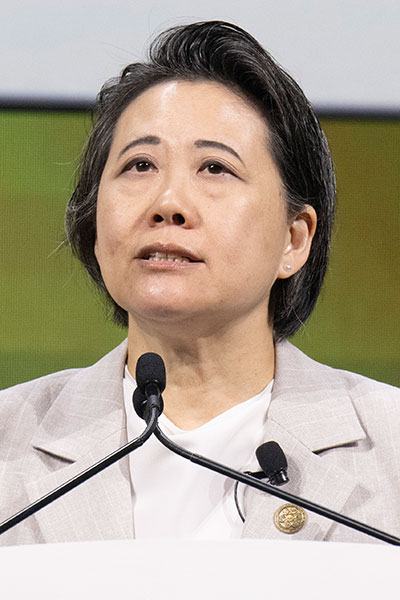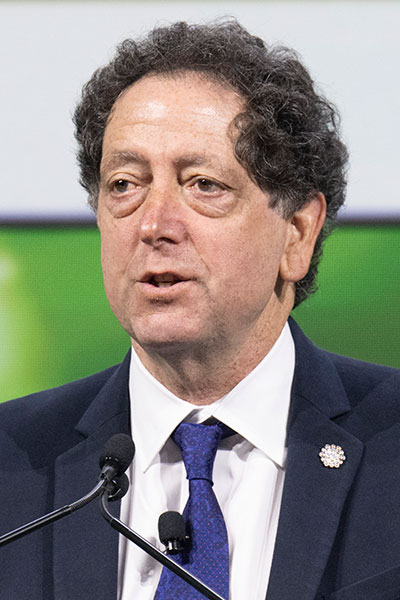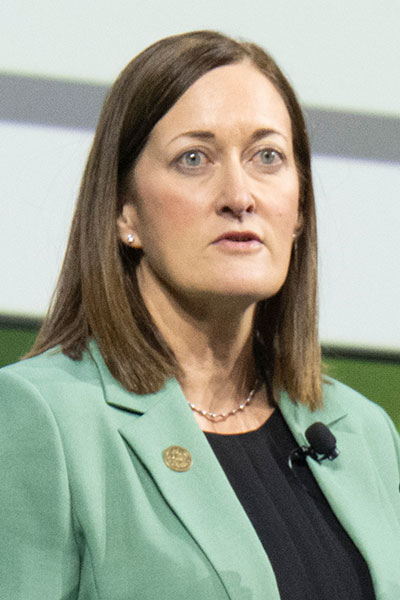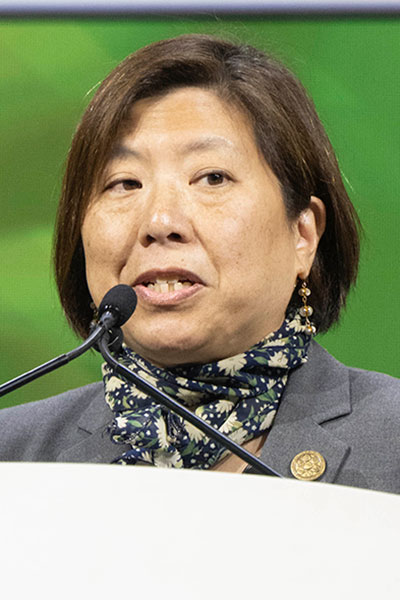Opening Plenary showcases the continuum of innovation for impact
The Opening Plenary Session: Unifying Cancer Science and Medicine—A Continuum of Innovation for Impact reflected the meeting theme of carrying discoveries to clinical impact and illustrated the breadth of cancer research captured by the AACR Annual Meeting 2025, with four leading researchers presenting on KRAS inhibition, extrachromosomal DNA (ecDNA), the tumor microenvironment, and cancer vaccines.

“These are four exciting and emerging areas of science that have relevance to not only the basic understanding of cancer biology but also have current or forthcoming implications for cancer research,” said Matthew G. Vander Heiden, MD, PhD, of Koch Institute for Integrative Cancer Research at MIT and Dana-Farber Cancer Institute.

“We are thrilled to have the field’s leading researchers covering these timely and diverse topics that underscore the continuum of cancer research,” said Lillian L. Siu, MD, FAACR, of Princess Margaret Cancer Centre, whose tenure as the 2025-2026 AACR President began yesterday.
Vander Heiden and Siu were this year’s Annual Meeting program chairs and the organizers of the Opening Plenary Session.
Siu noted, “We hope that this plenary session will introduce you to novel ideas, lead you in new directions, and motivate you to spend the next four days exploring the continuum of innovation to maximize impact for patients.”
From undruggable to druggable: what’s next for KRAS?
Kevan M. Shokat, PhD, FAACR, of University of California, San Francisco, kicked off the session with a presentation on new approaches to target KRAS-mutated cancers. He reminded attendees of the long history of KRAS, from its discovery in 1982, and the early, unsuccessful attempts to inhibit it, to present day, where two direct inhibitors of the KRAS G12C mutant are approved for clinical use.

The inhibition of KRAS—long considered undruggable—was a monumental advance for targeted therapy, and, as Shokat noted, researchers continue to explore strategies to improve KRAS-targeted therapy.
“Starting off with the [G12] cysteine, going after maybe not the most common, but the most chemically tractable mutant gave rise to a really exciting approach to target KRAS,” said Shokat, noting that new developments have demonstrated the potential to target additional KRAS mutants as well. “It has been a long journey but something that has proved possible.”
Shokat reported a new optimized lead compound that, in cell lines, effectively inhibited KRAS G12D in both its inactive and active forms. The development of new therapeutics against KRAS is ongoing, and Shokat pointed to inhibitors of active KRAS (RAS-ON inhibitors) and protein degraders as two promising approaches under investigation.
Understanding ecDNA’s emerging role in cancer
Paul S. Mischel, MD, FAACR, of Stanford University, began the second presentation of the session by showing attendees a black-and-white microscopy image of human chromosomes. He then displayed a higher exposure of the same image, revealing ecDNA—small circular DNA fragments with recently discovered roles in oncogene expression, cancer development and progression, immune modulation, and treatment resistance.

“Hiding in the nucleus, in plain sight, wreaking havoc,” said Mischel.
Mischel discussed these tumor-promoting roles of ecDNA and shared data demonstrating a vulnerability that could be exploited therapeutically. He showed how collisions between transcription and replication machinery on ecDNA activate the DNA damage protein CHK1, making the cancer cells vulnerable to CHK1 inhibition. The approach is currently under evaluation in a phase I clinical trial, Mischel noted.
He also presented efforts identifying additional therapeutic strategies. One potential approach is to ectopically express cGAS, a DNA-sensing protein that hinders ecDNA amplification and promotes immune responses upon detection of ecDNA. In mice, inducing ectopic expression of cGAS significantly shrank ecDNA-containing tumors and extended survival.
“We’ve come a long way in understanding the importance of [ecDNA] … It’s very prevalent, and it’s very devastating,” said Mischel. “I hope you will take away how important this type of biology is and why we have to tackle it.”
Unraveling the complexity of cancer ecosystems to prevent recurrence
Johanna A. Joyce, PhD, FAACR, of Ludwig Institute for Cancer Research, discussed treatment-induced alterations to the brain tumor microenvironment (TME) and how these present opportunities to prevent brain cancer recurrence.

Using animal models and spatial technologies, Joyce and colleagues examined the impact of treatment on the brain TME, observing that radiotherapy induces the formation of fibrotic scars in the brain and that the fibrotic scars had implications for outcomes.
“What was really quite striking is the emergence of fibrotic scars following radiation, and where the glioma recurs is precisely where that scar had formed,” said Joyce. “These scars may create a recurrence-permissive niche, supporting tumor cell survival, reawakening, and regrowth.”
This phenomenon was also observed after surgery and immunotherapy.
When the formation of radiation-induced fibrotic scars was inhibited, mice had significantly longer survival, suggesting a potential approach to improve outcomes.
“By blocking the formation of fibrotic scars, we can directly impact tumor recurrence,” Joyce concluded.
New opportunities for personalized cancer vaccines
Catherine J. Wu, MD, FAACR, of Dana-Farber Cancer Institute, closed out the Opening Plenary with a presentation highlighting the promise of personalized neoantigen cancer vaccines. She explained that tumor neoantigens offer a “sweet spot” vaccine target—highly expressed in tumors but not in normal tissue.

In recent years, clinical trials have demonstrated the efficacy of personalized neoantigen vaccines in treating cancers, including for high-risk melanoma and high-risk clear cell renal cell carcinoma, Wu noted.
In addition, she showed data suggesting that they may even be effective against ovarian cancer—a cancer type for which immunotherapies have largely been ineffective. According to clinical trial results reported by Wu, an investigational neoantigen-targeted vaccine led to stable disease in three of 10 patients with advanced ovarian cancer and induced a neoantigen-specific immune response. In contrast, tumors that progressed after vaccination exhibited signs of immune evasion.
“We are seeing a multitude of immune-evasive mechanisms at the time of progression,” said Wu. “We need to identify those events earlier on, and, certainly, understanding this will inform us on how to devise more rational approaches to address advanced disease.”
The recording of the full session is available for registered Annual Meeting attendees through October 2025 on the virtual meeting platform.
More from the AACR Annual Meeting 2025
View a photo gallery of scenes from Chicago, continue the conversation on social media using the hashtag #AACR25, and read more coverage in AACR Annual Meeting News.

